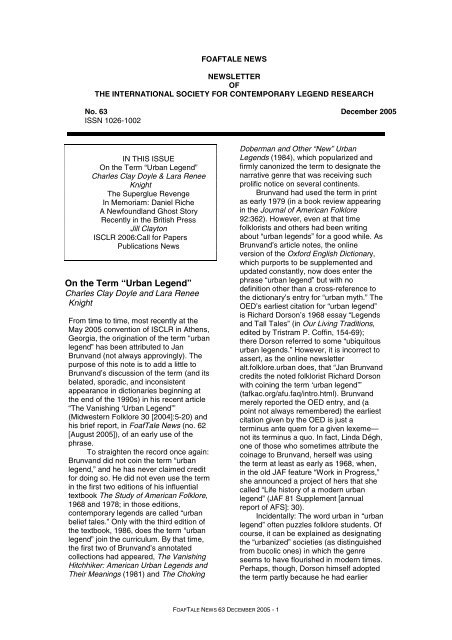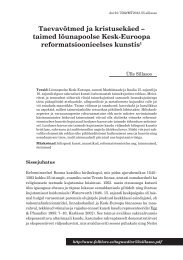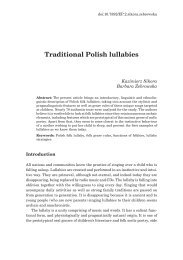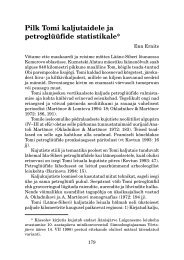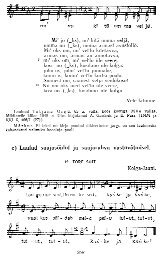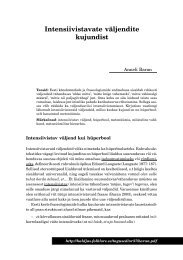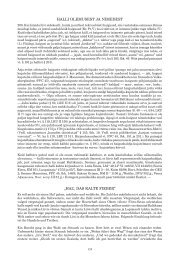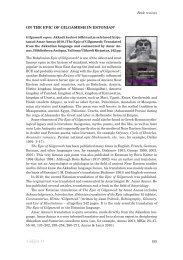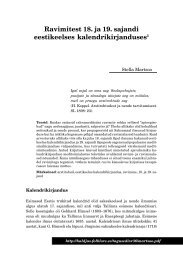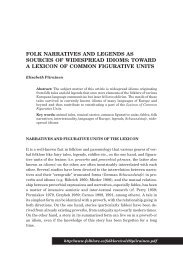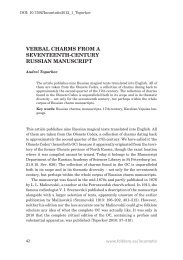On the Term ?Urban Legend? - Folklore.ee
On the Term ?Urban Legend? - Folklore.ee
On the Term ?Urban Legend? - Folklore.ee
Create successful ePaper yourself
Turn your PDF publications into a flip-book with our unique Google optimized e-Paper software.
FOAFTALE NEWS<br />
NEWSLETTER<br />
OF<br />
THE INTERNATIONAL SOCIETY FOR CONTEMPORARY LEGEND RESEARCH<br />
No. 63 December 2005<br />
ISSN 1026-1002<br />
IN THIS ISSUE<br />
<strong>On</strong> <strong>the</strong> <strong>Term</strong> “<strong>Urban</strong> <strong>Legend</strong>”<br />
Charles Clay Doyle & Lara Ren<strong>ee</strong><br />
Knight<br />
The Superglue Revenge<br />
In Memoriam: Daniel Riche<br />
A Newfoundland Ghost Story<br />
Recently in <strong>the</strong> British Press<br />
Jill Clayton<br />
ISCLR 2006:Call for Papers<br />
Publications News<br />
<strong>On</strong> <strong>the</strong> <strong>Term</strong> “<strong>Urban</strong> <strong>Legend</strong>”<br />
Charles Clay Doyle and Lara Ren<strong>ee</strong><br />
Knight<br />
From time to time, most recently at <strong>the</strong><br />
May 2005 convention of ISCLR in A<strong>the</strong>ns,<br />
Georgia, <strong>the</strong> origination of <strong>the</strong> term “urban<br />
legend” has b<strong>ee</strong>n attributed to Jan<br />
Brunvand (not always approvingly). The<br />
purpose of this note is to add a little to<br />
Brunvand’s discussion of <strong>the</strong> term (and its<br />
belated, sporadic, and inconsistent<br />
appearance in dictionaries beginning at<br />
<strong>the</strong> end of <strong>the</strong> 1990s) in his recent article<br />
“The Vanishing ‘<strong>Urban</strong> <strong>Legend</strong>’”<br />
(Midwestern <strong>Folklore</strong> 30 [2004]:5-20) and<br />
his brief report, in FoafTale News (no. 62<br />
[August 2005]), of an early use of <strong>the</strong><br />
phrase.<br />
To straighten <strong>the</strong> record once again:<br />
Brunvand did not coin <strong>the</strong> term “urban<br />
legend,” and he has never claimed credit<br />
for doing so. He did not even use <strong>the</strong> term<br />
in <strong>the</strong> first two editions of his influential<br />
textbook The Study of American <strong>Folklore</strong>,<br />
1968 and 1978; in those editions,<br />
contemporary legends are called “urban<br />
belief tales.” <strong>On</strong>ly with <strong>the</strong> third edition of<br />
<strong>the</strong> textbook, 1986, does <strong>the</strong> term “urban<br />
legend” join <strong>the</strong> curriculum. By that time,<br />
<strong>the</strong> first two of Brunvand’s annotated<br />
collections had appeared, The Vanishing<br />
Hitchhiker: American <strong>Urban</strong> <strong>Legend</strong>s and<br />
Their Meanings (1981) and The Choking<br />
FOAFTALE NEWS 63 DECEMBER 2005 - 1<br />
Doberman and O<strong>the</strong>r “New” <strong>Urban</strong><br />
<strong>Legend</strong>s (1984), which popularized and<br />
firmly canonized <strong>the</strong> term to designate <strong>the</strong><br />
narrative genre that was receiving such<br />
prolific notice on several continents.<br />
Brunvand had used <strong>the</strong> term in print<br />
as early 1979 (in a book review appearing<br />
in <strong>the</strong> Journal of American <strong>Folklore</strong><br />
92:362). However, even at that time<br />
folklorists and o<strong>the</strong>rs had b<strong>ee</strong>n writing<br />
about “urban legends” for a good while. As<br />
Brunvand’s article notes, <strong>the</strong> online<br />
version of <strong>the</strong> Oxford English Dictionary,<br />
which purports to be supplemented and<br />
updated constantly, now does enter <strong>the</strong><br />
phrase “urban legend” but with no<br />
definition o<strong>the</strong>r than a cross-reference to<br />
<strong>the</strong> dictionary’s entry for “urban myth.” The<br />
OED’s earliest citation for “urban legend”<br />
is Richard Dorson’s 1968 essay “<strong>Legend</strong>s<br />
and Tall Tales” (in Our Living Traditions,<br />
edited by Tristram P. Coffin, 154-69);<br />
<strong>the</strong>re Dorson referred to some “ubiquitous<br />
urban legends.” However, it is incorrect to<br />
assert, as <strong>the</strong> online newsletter<br />
alt.folklore.urban does, that “Jan Brunvand<br />
credits <strong>the</strong> noted folklorist Richard Dorson<br />
with coining <strong>the</strong> term ‘urban legend’”<br />
(tafkac.org/afu.faq/intro.html). Brunvand<br />
merely reported <strong>the</strong> OED entry, and (a<br />
point not always remembered) <strong>the</strong> earliest<br />
citation given by <strong>the</strong> OED is just a<br />
terminus ante quem for a given lexeme—<br />
not its terminus a quo. In fact, Linda Dégh,<br />
one of those who sometimes attribute <strong>the</strong><br />
coinage to Brunvand, herself was using<br />
<strong>the</strong> term at least as early as 1968, when,<br />
in <strong>the</strong> old JAF feature “Work in Progress,”<br />
she announced a project of hers that she<br />
called “Life history of a modern urban<br />
legend” (JAF 81 Supplement [annual<br />
report of AFS]: 30).<br />
Incidentally: The word urban in “urban<br />
legend” often puzzles folklore students. Of<br />
course, it can be explained as designating<br />
<strong>the</strong> “urbanized” societies (as distinguished<br />
from bucolic ones) in which <strong>the</strong> genre<br />
s<strong>ee</strong>ms to have flourished in modern times.<br />
Perhaps, though, Dorson himself adopted<br />
<strong>the</strong> term partly because he had earlier
discussed such legends (including his<br />
famous tracing of <strong>the</strong> origin of “The Death<br />
Car”) in a sub-chapter entitled “Folktales<br />
and <strong>Legend</strong>s of <strong>the</strong> Big City” in his book<br />
American <strong>Folklore</strong> ([1959], 245-54). Back<br />
in 1952, J. Russell Reaver entitled an<br />
article “‘Embalmed Alive’: A Developing<br />
<strong>Urban</strong> Ghost Tale,” in which he remarked,<br />
“Tales from city folk form a valuable but<br />
ra<strong>the</strong>r neglected part of folk-literature”<br />
(New York <strong>Folklore</strong> Quarterly 8: 217-20).<br />
As its second-oldest citation, <strong>the</strong> OED<br />
gives Daniel Barnes’s 1971 reference (in<br />
American Literature 43:119) to a paper by<br />
Patrick Mullen, “<strong>Urban</strong> <strong>Legend</strong> and Rumor<br />
Theory”; <strong>the</strong> paper itself was published in<br />
1972, now with <strong>the</strong> title “Modern <strong>Legend</strong><br />
and Rumor Theory” (Journal of <strong>the</strong><br />
<strong>Folklore</strong> Institute 9:95-109). Mullen<br />
observed, “Although <strong>the</strong> terms urban<br />
legend and urban belief tale are widely<br />
used today, <strong>the</strong>y are somewhat<br />
misleading” (95). Note <strong>the</strong> assertion that<br />
(in 1972) <strong>the</strong> term “urban legend” was<br />
already being “widely used.” A 1972<br />
column by Bill Gold in <strong>the</strong> Washington<br />
Post (an installment of his regular feature<br />
“The District Line”) had <strong>the</strong> title “Origins of<br />
<strong>Urban</strong> <strong>Legend</strong>s Baffle Experts” (19 May;<br />
B22).<br />
As for <strong>the</strong> cross-referenced cognate<br />
term “urban myth,” misnomer though it is:<br />
The OED gives an earlier instance than its<br />
earliest for “urban legend.” In 1960, W. H.<br />
Friedland entitled a paper “Some <strong>Urban</strong><br />
Myths in East Africa” (in <strong>the</strong> collection<br />
Myth in Modern Africa, edited by Allie<br />
Dubb [Lusaka Nor<strong>the</strong>rn Rhodesia (now<br />
Zambia)], 83-97). There, however, <strong>the</strong><br />
phrase “urban myths” does not refer<br />
specifically to contemporary legends but<br />
ra<strong>the</strong>r, broadly, to rumors, superstitions,<br />
stereotypes, customs, and o<strong>the</strong>r lore that<br />
Friedland found in African cities. The<br />
OED’s second-oldest citation is from 1986<br />
(in <strong>the</strong> Toronto Star), a whole quartercentury<br />
later.<br />
To pencil in <strong>the</strong> gap a bit: In 1961 <strong>the</strong><br />
New York Times quoted a local official<br />
who referred to an “anti-urban myth,” <strong>the</strong><br />
assumption that city schools must be<br />
inferior to suburban ones. In somewhat<br />
<strong>the</strong> same vein, Robert Walker, in “The<br />
Poet and <strong>the</strong> Rise of <strong>the</strong> City,” wrote of <strong>the</strong><br />
“urban myth” perpetrated by “<strong>the</strong> city’s<br />
critics” with <strong>the</strong>ir “negative reaction” to<br />
things urban (Mississippi Valley Historical<br />
Review 49 [1962]:99). In 1963 Parker<br />
Tyler, in “An American Theater Motif: The<br />
Psychodrama,” referred to one “urban<br />
FOAFTALE NEWS 63 DECEMBER 2005 - 2<br />
myth” (presumably among o<strong>the</strong>rs), <strong>the</strong><br />
flawed-but-heroic movie lawman<br />
(American Quarterly 15:148). In 1971<br />
Richard Macksey, in a review of Nathan<br />
Scott’s Negative Capability, referred to<br />
James Joyce’s “cosmic urban myth” (MLN<br />
86:608). Commenting on a 1972 book that<br />
“calls into question some fundamental<br />
notions of African Studies,” which had<br />
“long b<strong>ee</strong>n dominated by an ‘urban’ bias,”<br />
Joseph Smaldone declared, “The ‘urban<br />
myth’ has b<strong>ee</strong>n exploded”<br />
(“Socioeconomic Study of <strong>the</strong> Hausa,”<br />
African Studies Review 16 [1973]:150-51).<br />
In a 1975 book review, C. Nicholas L<strong>ee</strong><br />
wrote that E. C. Barksdale “proc<strong>ee</strong>ds to<br />
discuss <strong>the</strong> urban myth as used by Gogol<br />
and Dostoevskij” (Slavic and East<br />
European Journal 19:334)—“<strong>the</strong> urban<br />
myth” in contrast to “<strong>the</strong> pastoral myth.” In<br />
1976 George W. Carey referred to “<strong>the</strong><br />
Jeffersonian anti-urban myth” (“Land<br />
Tenure, Speculation, and <strong>the</strong> State of <strong>the</strong><br />
Aging Metropolis,” Geographical Review<br />
66:253). In 1980 Sharon Zukin wondered<br />
whe<strong>the</strong>r, “after <strong>the</strong> demystification of<br />
urbanization and urbanism, <strong>the</strong>re is still an<br />
urban culture or an urban myth which is<br />
not merely determined by ei<strong>the</strong>r capital or<br />
technology” (“A Decade of <strong>the</strong> New <strong>Urban</strong><br />
Sociology,” Theory and Society 9:598).<br />
In none of those early instances is <strong>the</strong><br />
term “urban myth” being used in a way<br />
that’s really synonymous with “urban<br />
legend”; <strong>the</strong> references are simply to<br />
anything <strong>the</strong> word myth or mythology can<br />
designate, in relation to cities. So <strong>the</strong><br />
OED’s definition of “urban myth”—viz. “a<br />
sensational but apocryphal story which<br />
through repetition in varying versions has<br />
acquired <strong>the</strong> status of folklore, esp. one<br />
lent plausibility by its contemporary<br />
setting, or by <strong>the</strong> purported involvement of<br />
someone known to <strong>the</strong> teller”—is<br />
problematical, prior to <strong>the</strong> 1980s, at least.<br />
Therefore, <strong>the</strong> dictionary’s cross reference<br />
from “urban legend” is not appropriate,<br />
since “urban legend” clearly antedates<br />
“urban myth” in <strong>the</strong> defined sense. Of<br />
course, sometimes a collocation will<br />
become familiar, <strong>the</strong>n “fixed” as a<br />
phrase—<strong>the</strong>n only later take on a certain<br />
idiomatic sense.<br />
In any case, we recently discovered a<br />
very early occurrence of <strong>the</strong> phrase “urban<br />
legend”—not used in <strong>the</strong> folkloristic sense<br />
but <strong>the</strong> same collocation none<strong>the</strong>less.<br />
From an unsigned column in <strong>the</strong> New York<br />
Times for 6 December 1925, “Europe’s<br />
Population Growth” (E12): “Around <strong>the</strong>
subject of population <strong>the</strong>re has b<strong>ee</strong>n a<br />
growth of popular legend hard to remove.<br />
Great Britain illustrates <strong>the</strong> urban legend.”<br />
The “urban legend” (so designated)<br />
maintains that life in urbanized societies,<br />
plagued by slums and squalor, must be<br />
nasty and short. In fact, though, “Great<br />
Britain with a population of 78 per cent.<br />
urban shows an incomparably higher level<br />
of health than France with an urban<br />
population of only 46 per cent.” The<br />
depopulation experienced by some<br />
European countries resulted not from a<br />
low birth-rate (as was generally supposed<br />
by demographers at <strong>the</strong> time) but from a<br />
high death-rate: “In Great Britain <strong>the</strong>re<br />
were in 1924, for every 100 births, 65<br />
deaths; in Germany, 68 deaths; in France,<br />
87 deaths.”<br />
As with all <strong>the</strong> early examples of <strong>the</strong><br />
term “urban myth,” <strong>the</strong> 1925 instance of<br />
“urban legend” refers not to what<br />
folklorists nowadays would call a<br />
“contemporary legend” but ra<strong>the</strong>r, simply,<br />
to a recurring belief or assumption about<br />
urban life, urban affairs, urbanization. But<br />
<strong>the</strong> phrase was now in <strong>the</strong> language,<br />
ready to take on o<strong>the</strong>r meanings—waiting<br />
for Jan Brunvand.<br />
University of Georgia<br />
The Superglue Revenge<br />
Recently a postgraduate at <strong>the</strong> Delargy<br />
Centre for Irish <strong>Folklore</strong> and National<br />
<strong>Folklore</strong> Collection, University College<br />
Dublin handed me a clipping from <strong>the</strong> Irish<br />
Times which he had spotted that day. I<br />
<strong>the</strong>n consulted Brian Chapman’s database<br />
of contemporary legends and found no<br />
fewer than 15 o<strong>the</strong>r versions. Brian later<br />
forwarded me 4 more that he had recently<br />
noted, and which proved to be fur<strong>the</strong>r<br />
reports of <strong>the</strong> same case.<br />
I had not s<strong>ee</strong>n this particular legend<br />
since Mark Glazer’s essay on 22 versions<br />
from <strong>the</strong> Rio Grande <strong>Folklore</strong> Archive,<br />
printed in Monsters with Iron T<strong>ee</strong>th:<br />
Perspectives on Contemporary <strong>Legend</strong> III<br />
(Sheffield, 1988). For readers’ delight and<br />
edification, I print below <strong>the</strong> article from<br />
<strong>the</strong> Irish Times and a selection of Brian<br />
Chapman’s versions. Editor.<br />
FOAFTALE NEWS 63 DECEMBER 2005 - 3<br />
MAN SUES EX-GIRLFRIEND FOR<br />
SUPER-GLUING GENITALS<br />
A man is suing his ex-girlfriend for more<br />
than $16,000 ( 13,500) for super-gluing<br />
his genitals to his stomach.<br />
Kenneth Slaby, of Pittsburgh, is suing<br />
Gail O’Toole, with whom he broke up in<br />
1999 after dating for 10 months.<br />
Mr Slaby <strong>the</strong>n began dating someone<br />
else but, according to <strong>the</strong> lawsuit, Ms<br />
O’Toole invited him over to her home on<br />
May 7 th , 2000, where he fell asl<strong>ee</strong>p.<br />
When he woke up, Mr Slaby found<br />
Ms O’Toole had used super glue to stick<br />
his genitals to his abdomen, had glued his<br />
buttocks toge<strong>the</strong>r and had spelled out a<br />
profanity on his back in nail polish. Ms<br />
O’Toole allegedly told him it was a<br />
payback for <strong>the</strong>ir break-up, and he had to<br />
walk a mile to a petrol station to call for<br />
help.<br />
“This was not just some petty<br />
domestic quarrel,” said Mr Slaby’s lawyer,<br />
Grey Pratt.<br />
Ms O’Toole had pleaded guilty to<br />
misdemeanour assault and served six<br />
months’ probation, but Mr Slaby is now<br />
suing for damages.<br />
Ms O’Toole’s lawyer, Chuck Evans,<br />
said it was a consensual act and Mr Slaby<br />
was not permanently damaged. “This is a<br />
case that should have b<strong>ee</strong>n left in <strong>the</strong><br />
bedroom,” he said. _ (AP).<br />
The Irish Times, World News (5<br />
November, 2005). Courtesy Peter<br />
McGuire.<br />
2.<br />
Extracts from two fur<strong>the</strong>r reports from<br />
Pittsburg. Courtesy Brian Chapman.<br />
Glue Suit Day 2: Scorned Lover,<br />
Glue, Naked Man And Elvis?<br />
Westmoreland County, Pa.<br />
Late Thursday, <strong>the</strong> woman accused of<br />
using glue as a tool for revenge against an<br />
ex-lover told her side of <strong>the</strong> story in court.<br />
Her side involved a story of a wedding<br />
proposal, a night of love and plans for Las<br />
Vegas nuptials. That was a very different<br />
story from <strong>the</strong> tale of stalking, torture and<br />
abuse <strong>the</strong> man who's suing her told <strong>the</strong><br />
court.<br />
After <strong>the</strong>ir 10-month relationship<br />
came to an end, according to Gail<br />
O'Toole, she and Ken Slaby attempted to
ekindle <strong>the</strong> flame. They went to an oldies<br />
dance, followed by a night of lovemaking,<br />
O'Toole said.<br />
The next day, O'Toole said Slaby<br />
proposed, inviting her to <strong>the</strong> Elvis Chapel<br />
of Love in Las Vegas. She claimed Slaby<br />
even bid on a ring. There was just one<br />
problem, according to O'Toole -- Slaby<br />
already promised <strong>the</strong> trip and <strong>the</strong> ring to<br />
ano<strong>the</strong>r woman.<br />
The jury is weighing whe<strong>the</strong>r that<br />
revelation could have thrown O'Toole into<br />
a fit of rage so outrageous that she<br />
drugged Slaby, waited until he fell asl<strong>ee</strong>p,<br />
<strong>the</strong>n glued his penis to his stomach, his<br />
testicles to his leg and his buttocks<br />
toge<strong>the</strong>r.<br />
O'Toole said it was part of a sex<br />
game -- so was <strong>the</strong> nail polish, which she<br />
said she used to paint sideburns on him in<br />
honor of Elvis.<br />
http://www.<strong>the</strong>pittsburghchannel.com/new<br />
s/5242347/detail.html<br />
ThePittsburghChannel.com | 3 November<br />
2005.<br />
It's Just Ano<strong>the</strong>r Tacky Story In<br />
Super Glue Inventor's Book<br />
By Dennis B. Roddy, Pittsburgh Post-<br />
Gazette<br />
To Harry Coover, <strong>the</strong> story was<br />
nothing new: someone coming a bit<br />
unstuck, and super-gluing body parts to<br />
o<strong>the</strong>r body parts. The story, until five years<br />
ago, existed largely as urban legend. It<br />
would have an angry wife or jilted girlfriend<br />
applying <strong>the</strong> miracle adhesive to <strong>the</strong><br />
wandering spouse’s ne<strong>the</strong>r regions, and<br />
<strong>the</strong> philandering guy s<strong>ee</strong>king medical help.<br />
"Yes, I heard some of those stories. We<br />
had a small group that was collecting all<br />
<strong>the</strong>se stories from papers and publications<br />
and all that," Dr. Coover said. He had a<br />
reason to wonder if <strong>the</strong>se legends could<br />
be true.<br />
Harry Coover, Ph.D., invented super<br />
glue. [...]<br />
As companies sold Super Glue and<br />
Krazy Glue during <strong>the</strong> 1970s, legends<br />
began to surface about angry women and<br />
some very surprised men who awoke from<br />
naps to find <strong>the</strong>y'd become stuck on<br />
<strong>the</strong>mselves. "What we did," he said, "was<br />
check out several of <strong>the</strong>m to confirm that<br />
<strong>the</strong>y were real and <strong>the</strong> consequence of<br />
that was we changed <strong>the</strong> wording on<br />
safety use of super glues -- things that you<br />
should not do." Things like what Gail<br />
FOAFTALE NEWS 63 DECEMBER 2005 - 4<br />
O'Toole admitted doing to Kenneth Slaby,<br />
who yesterday won $46,200 in damages<br />
for his super-gluing five years ago. "That<br />
could be very dangerous, of course," Dr.<br />
Coover said. "There's even cases in<br />
college where <strong>the</strong>y put it on toilet seats<br />
and <strong>the</strong>y had to take <strong>the</strong> toilet seat off and<br />
take <strong>the</strong> guy to <strong>the</strong> hospital and had to<br />
provide some advice on how to remove it."<br />
Just in case, from <strong>the</strong> inventor, here's a<br />
tip: warm water, a great deal of it, as<br />
quickly as possible. Acetates, like nail<br />
polish remover, also help, but <strong>the</strong>y're a bit<br />
toxic. The best advice might be to leave<br />
super gluing to <strong>the</strong> experts.<br />
http://www.postgazette.com/pg/05309/601174.stm<br />
Pittsburgh Post-Gazette | 5 November<br />
2005<br />
Brian’s database features stories from<br />
1995 to 2005. Not only are genitals<br />
superglued but eye-lids and lips are glued<br />
toge<strong>the</strong>r as well. In one story a woman’s<br />
face is glued to her pillow while she<br />
sl<strong>ee</strong>ps. Here are two of <strong>the</strong> grizzliest, one<br />
from <strong>the</strong> British press and one via internet<br />
newsgroups.<br />
Daily Telegraph 22 June 2001<br />
Smuggled Migrant's Lips Sealed<br />
With Glue<br />
By Stewart Payne<br />
A TEENAGE illegal immigrant has b<strong>ee</strong>n<br />
found with his lips glued toge<strong>the</strong>r to<br />
prevent him from informing on his<br />
smugglers.<br />
The 17-year-old Iraqi is believed to<br />
have b<strong>ee</strong>n bundled off a ship in<br />
Southampton within <strong>the</strong> past w<strong>ee</strong>k. He<br />
was given medical attention after being<br />
found slumped in a doorway at nearby<br />
Eastleigh on Monday and is being<br />
questioned at an immigrant detention<br />
centre.<br />
Hampshire police said a couple who<br />
found him thought at first that he was<br />
drunk because he could only mumble. The<br />
youth scribbled on a piece of paper to<br />
indicate where he came from.<br />
Later it became clear that thr<strong>ee</strong> men<br />
had used glue to seal his lips before he<br />
was smuggled off <strong>the</strong> ship. The couple
said <strong>the</strong> youth was lying in <strong>the</strong> doorway of<br />
a sports pavilion.<br />
The woman, who asked not to be<br />
named, said: "My husband and I thought<br />
he was asl<strong>ee</strong>p, drunk or drugged. He<br />
s<strong>ee</strong>med to be foaming at <strong>the</strong> mouth, <strong>the</strong>n<br />
we realised it was super-glue. He wrote<br />
down that he was an Iraqi and to call <strong>the</strong><br />
police. He also wrote that Saddam<br />
[Hussein] was a bad man."<br />
The woman said his f<strong>ee</strong>t were<br />
covered in blisters after walking for several<br />
miles without shoes. The Immigration<br />
Service said that no decision had b<strong>ee</strong>n<br />
made on <strong>the</strong> youth's future.<br />
http://www.telegraph.co.uk/et?ac=002633<br />
285515118&rtmo=rQrr2Q9X&atmo=llllll<br />
Newport, Tenn., Aug. 9 (UPI)<br />
A grand jury in Tenness<strong>ee</strong> has b<strong>ee</strong>n<br />
asked to consider a sticky situation<br />
involving a man who glued shut his wife’s<br />
private parts.<br />
Franklin James was scheduled to<br />
appear at a preliminary hearing Friday, but<br />
he waived that right and his case was<br />
bound over to <strong>the</strong> grand jury. James is<br />
charged with gluing his wife's vagina shut<br />
while she was sl<strong>ee</strong>ping.<br />
Police Detective Robert Caldwell<br />
says James told investigators he put<br />
Super Glue on his wife because she "was<br />
cheating on him and he wanted to teach<br />
her a lesson."<br />
Teresa James says <strong>the</strong> incident<br />
occurred June 10 after she had taken two<br />
pain pills for a headache before going to<br />
sl<strong>ee</strong>p. She says she discovered what had<br />
happened <strong>the</strong> next morning.<br />
Teresa James obtained a restraining<br />
order against her husband, but a lawyer<br />
said Friday that <strong>the</strong> couple is living<br />
toge<strong>the</strong>r again. Public Defender Susan<br />
Thomas says <strong>the</strong> Jameses are planning to<br />
move to North Carolina.<br />
Newsgroups:<br />
clari.local.tenness<strong>ee</strong>,clari.news.crime.sex,<br />
clari.news.crime.assaults,clari.news.crime.<br />
general<br />
Subject: Man accused of gluing wife<br />
From: C-upi@clari.net (UPI)<br />
Date: Sat, 9 Aug 1997 6:10:29 PDT<br />
END<br />
FOAFTALE NEWS 63 DECEMBER 2005 - 5<br />
In Memoriam:<br />
Daniel Riche (1949-2005)<br />
Daniel Riche, who played an important<br />
role in French science fiction, died on<br />
Sunday 21 August after a long illness. He<br />
was 56 years old. For several years he<br />
had b<strong>ee</strong>n <strong>the</strong> chief editor of Fiction, <strong>the</strong><br />
principal journal of <strong>the</strong> genre.<br />
Subsequently he founded <strong>the</strong> ambitious<br />
review Science and Fiction (éditions<br />
Denoël), which had notably devoted<br />
numerous special issues to Philip K. Dick<br />
and J.G. Ballard, <strong>the</strong>n <strong>the</strong> journal Orbites<br />
(éditions Néo).<br />
A talented anthologist, he had put<br />
toge<strong>the</strong>r several “Livres d’or de la sciencefiction”<br />
for Presses Pocket devoted to<br />
Richard Mat<strong>the</strong>son (1981), Clifford D.<br />
Simak (1985), Damon Knight (1987), and<br />
had conceived <strong>the</strong> first anthology about<br />
“steampunk,’ Futurs Antérieurs (Fleuve<br />
noir, 1999). He oversaw a collection of<br />
works about criminal cases in <strong>the</strong> French<br />
provinces with <strong>the</strong> Presses de la<br />
Renaissance, in which series he was<br />
himself responsible for Histoires<br />
criminelles de Paris, Île-de-France, and<br />
Histoires criminelles du Lyonnais. He also<br />
published Grands procès et affaires<br />
criminelles du Lyonnais (1982). For Fleuve<br />
noir, he created and directed <strong>the</strong><br />
controversial collection “Gore,” <strong>the</strong>n <strong>the</strong><br />
compilation “Aventures et Mystères.”<br />
Translator, author of a work on chemical<br />
and bacteriological warfare (Belfond<br />
1982), and a study entitled “La Bande<br />
Dessinée de Science-fiction Américaine”<br />
with Albin Michel (1976), during his last<br />
years Daniel Riche had distanced himself<br />
from publishing and had embarked on a<br />
car<strong>ee</strong>r as a television script-writer. He<br />
worked in particular on <strong>the</strong> series “Brigade<br />
spéciale” for TF1, and “Nestor Burma” for<br />
France 2.<br />
First published in Le Monde (28 August<br />
2005). Translation, G. Bennett. Sent by<br />
Véronique Campion-Vincent, who adds:<br />
Daniel Riche authored in 1981 (with Jean-<br />
Luc Formental) a pion<strong>ee</strong>r article, “Les<br />
légendes urbaines,” in <strong>the</strong> magazine Métal<br />
Hurlant (68-75). It was a panorama of <strong>the</strong><br />
urban legends of <strong>the</strong> 1960s and 1970s<br />
and contained inspired illustrations by Di<br />
Marco, a specialist in horrible fait-divers.
A Newfoundland Ghost Story<br />
This happened in a little town in<br />
Newfoundland, and even though it sounds<br />
like an Alfred Hitchcock tale, it's absolutely<br />
true.<br />
A guy was on <strong>the</strong> side of <strong>the</strong> road<br />
hitch hiking on a very dark night in <strong>the</strong><br />
middle of a terrible rainstorm; no cars<br />
were on <strong>the</strong> road. The storm was so<br />
strong, <strong>the</strong> guy could hardly s<strong>ee</strong> a few f<strong>ee</strong>t<br />
ahead of him. Suddenly, he saw a car<br />
come toward him and stop. The guy,<br />
without thinking about it, got in <strong>the</strong> car and<br />
closed <strong>the</strong> door and only <strong>the</strong>n did he<br />
realize <strong>the</strong>re was nobody behind <strong>the</strong><br />
wh<strong>ee</strong>l!<br />
The car started to move very slowly.<br />
The guy looked at <strong>the</strong> road and saw a<br />
curve coming his way. Petrified, he started<br />
to pray, begging for his life. He had not<br />
come out of shock when, just before <strong>the</strong><br />
car hit <strong>the</strong> curve, a hand suddenly<br />
appeared through <strong>the</strong> window and moved<br />
<strong>the</strong> st<strong>ee</strong>ring wh<strong>ee</strong>l. The guy, now<br />
paralyzed in terror, watched how <strong>the</strong> hand<br />
appeared every time <strong>the</strong> car was<br />
approaching a curve. Finally, although<br />
terrified, <strong>the</strong> guy managed to open <strong>the</strong><br />
door and jump out of <strong>the</strong> spooky car.<br />
Without looking back, <strong>the</strong> guy ran through<br />
<strong>the</strong> storm all <strong>the</strong> way to <strong>the</strong> nearest town.<br />
Soaking wet, exhausted and in a<br />
state of utter shock, <strong>the</strong> pale visibly<br />
shaken guy walked into a nearby bar and<br />
asked for two shots of Scr<strong>ee</strong>ch. Then, still<br />
trembling with fright, he started telling<br />
everybody in <strong>the</strong> bar about <strong>the</strong> horrible<br />
experience he just went through with a<br />
spooky car with no driver and <strong>the</strong><br />
mysterious hand that kept appearing.<br />
Everyone in <strong>the</strong> bar listened in silence and<br />
became frightened, listening to this <strong>ee</strong>rie<br />
story, hairs stood on end when <strong>the</strong>y<br />
realized <strong>the</strong> guy was telling <strong>the</strong> truth<br />
because he was crying and he definitely<br />
was not drunk!<br />
About half an hour later, two guys<br />
walked into <strong>the</strong> same bar and one said to<br />
<strong>the</strong> o<strong>the</strong>r, "Look, me son, <strong>the</strong>re's <strong>the</strong> arse<br />
hole who got into <strong>the</strong> car while we were<br />
pushing it!"<br />
From : Paul Smith <br />
Sent via email 16 November, 2005<br />
FOAFTALE NEWS 63 DECEMBER 2005 - 6<br />
Recently in <strong>the</strong> British Press<br />
Jill Clayton<br />
The Guardian (8 October 2005, p. 7)<br />
under <strong>the</strong> headline “Cracked? Addict<br />
Squirrels Alert,” Patrick Barkham wrote:<br />
If <strong>the</strong>y are not launching <strong>the</strong>mselves at<br />
you in drug-fuelled desperation, <strong>the</strong>ir<br />
bloodshot eyes are searching for <strong>the</strong>ir next<br />
fix, pink paws scrabbling in <strong>the</strong> ground ...<br />
Squirrels in south London could have<br />
become addicted to crack cocaine, say<br />
residents of Brixton, who suggest <strong>the</strong><br />
rodents have dug up drugs buried by<br />
dealers or nibbled residues of crack on<br />
pipes and vials discarded by addicts.<br />
According to internet legend,<br />
crack squirrels have terrorised residents in<br />
New York and Washington. But is <strong>the</strong><br />
Brixton crack squirrel real or an urban<br />
myth? .... “They used to hang out in <strong>the</strong><br />
little park in front of <strong>the</strong> Ritzy, twitching ...<br />
dancing to music only <strong>the</strong>y could hear and<br />
generally creating a malevolent<br />
ambience,” Londoner Rik Abel wrote in his<br />
blog. Ritzy regulars were less sure, “I’ve<br />
never s<strong>ee</strong>n one,” said a staff member.<br />
“But <strong>the</strong>re might be crack foxes around.”<br />
[...]<br />
But Brixton crack squirrels n<strong>ee</strong>d not<br />
worry about <strong>the</strong> police yet. “I’ve no<br />
knowledge of that at all, “said a Scotland<br />
Yard spokesman, firmly.<br />
The Guardian (26 October 2005, p 4)<br />
carried an article by Ian Sample, “When<br />
Sl<strong>ee</strong>p’s an Alien Experience.”<br />
Strange encounters of <strong>the</strong> alien kind have more<br />
to do with sl<strong>ee</strong>p disorders than little gr<strong>ee</strong>n men<br />
with a penchant for kidnapping, according to a<br />
study. A survey of people who believed <strong>the</strong>y<br />
had had contact with aliens showed <strong>the</strong>y were<br />
much more likely to experience sl<strong>ee</strong>p paralysis,<br />
a state where people are temporarily stuck<br />
betw<strong>ee</strong>n sl<strong>ee</strong>p and wakefulness and unable to<br />
move ... often people will s<strong>ee</strong> bright lights and<br />
menacing figures and given <strong>the</strong> choice<br />
betw<strong>ee</strong>n truth and madness, many decide <strong>the</strong><br />
experience was real..<br />
Sl<strong>ee</strong>p paralysis itself was not enough to<br />
explain beliefs of alien encounters on its own,<br />
according to <strong>the</strong> survey. Most “experiencers”<br />
already had an interest in <strong>the</strong> paranormal ...<br />
They also had “dissociative tendencies”,<br />
meaning <strong>the</strong>y could be almost oblivious to <strong>the</strong>ir<br />
actions for periods of time. [...] “It makes <strong>the</strong>m<br />
f<strong>ee</strong>l special. These aliens have travelled across<br />
half <strong>the</strong> cosmos for <strong>the</strong>m. It’s just a shame<br />
<strong>the</strong>y’re not more careful with <strong>the</strong>ir probes.”
ISCLR Conference 2006<br />
Copenhagen, Denmark,<br />
May 29 – June 1, 2006<br />
The International Society for<br />
Contemporary <strong>Legend</strong> Research is<br />
pleased to announce that <strong>the</strong> 2006<br />
Perspectives on Contemporary <strong>Legend</strong><br />
Twenty-fourth International Conference is<br />
to be held in <strong>the</strong> ‘Blixen Room’ in <strong>the</strong><br />
‘Black Diamond’ building of <strong>the</strong> Royal<br />
Library in Copenhagen, Denmark.<br />
(http://www.kb.dk/kultur/diamant/indexen.htm).<br />
Also, in connection with <strong>the</strong><br />
conference <strong>the</strong>re will be a reception and<br />
tour of <strong>the</strong> collections and facilities at <strong>the</strong><br />
nearby Dansk Folkemindesamling<br />
(http://www.dafos.dk/index.htm).<br />
Copenhagen quite often is wonderful at<br />
this particular time of <strong>the</strong> year, and <strong>the</strong><br />
conference will take place in <strong>the</strong> very<br />
centre of <strong>the</strong> city, within comfortable<br />
walking distance of sights, shopping and<br />
suitable settings for socializing.<br />
Proposals for papers on all aspects of<br />
"contemporary," "urban," or "modern"<br />
legend research are sought, as are those<br />
on any legend or legend-like tradition that<br />
circulate actively at present or have<br />
circulated at an earlier historical period.<br />
Previous discussions have ranged in focus<br />
from <strong>the</strong> ancient to <strong>the</strong> modern (including<br />
Internet-lore) and have covered diverse<br />
cultures worldwide (including our own<br />
academic world).<br />
The 2006 m<strong>ee</strong>ting will be organized as a<br />
series of seminars at which <strong>the</strong> majority of<br />
those who attend will present papers<br />
and/or contribute to discussion sessions.<br />
Concurrent sessions will be avoided so<br />
that all participants can hear all <strong>the</strong><br />
papers. Proposals for special panels of<br />
papers, discussion sessions, and o<strong>the</strong>r<br />
related events are encouraged.<br />
Travel<br />
Kastrup Airport is located about 15<br />
kilometers from <strong>the</strong> centre of<br />
Copenhagen. The easiest (and often <strong>the</strong><br />
quickest) way to reach <strong>the</strong> city centre is to<br />
take a train from <strong>the</strong> airport to<br />
Hovedbanegaarden, <strong>the</strong> central station.<br />
However, <strong>the</strong> hotel is located about a<br />
kilometre from <strong>the</strong> main station, so<br />
depending on how much luggage you<br />
have, you may n<strong>ee</strong>d a cab from <strong>the</strong>re.<br />
FOAFTALE NEWS 63 DECEMBER 2005 - 7<br />
During <strong>the</strong> day, <strong>the</strong> train runs every ten<br />
minutes from <strong>the</strong> airport station. S<strong>ee</strong>:<br />
http://www.cph.dk/CPH/UK/MAIN/Getting+<br />
Here/ Renting a car is possible, but<br />
expensive and not recommended for a<br />
stay in Copenhagen. Taking a taxi from<br />
Kastrup Airport to <strong>the</strong> Cab Inn City hotel<br />
will cost approximately 150-200 Danish<br />
Kroner, but will get you <strong>the</strong>re directly.<br />
Accommodation<br />
Rooms are reserved at <strong>the</strong> CAB INN City<br />
hotel, a short walk from ‘<strong>the</strong> Black<br />
Diamond.’<br />
Standard rooms: 525,- Dkr., single; 645,-<br />
Dkr., double. (‘Commodore class’ and<br />
Captain’s class’ rooms also available at<br />
rates up to 845,- Dkr. for a Captain’s Class<br />
double room). All rooms have shower/<br />
bathrooms, TV, and kettles + fr<strong>ee</strong> coff<strong>ee</strong> &<br />
tea, but breakfast is not included. Instead<br />
<strong>the</strong> hotel has a ‘morning café.’ Parking is<br />
available at 120 Dkr. per day.<br />
For more information and booking s<strong>ee</strong>:<br />
http://www.capinn.com/UK/index.htm<br />
The Cab Inn City hotel is located across<br />
<strong>the</strong> str<strong>ee</strong>t from Copenhagen’s main police<br />
station, very close to Tivoli and <strong>the</strong><br />
Glyptoteket museum (classical Gr<strong>ee</strong>k,<br />
Roman, and Egyptian art) and less than a<br />
kilometre from <strong>the</strong> main square/ city hall<br />
(Rådhuspladsen) and Strøget.<br />
CAB INN City<br />
Mitchellsgade 14<br />
DK-1568 København C.<br />
Tel. (+45) 33461616<br />
Fax: (+45) 33461717<br />
E-mail: city@cabinn.com<br />
When making reservations, please include<br />
<strong>the</strong> ISCLR booking reservation number:<br />
33305<br />
To participate in <strong>the</strong> conference, please<br />
forward a title and abstract, along with <strong>the</strong><br />
appropriate conference f<strong>ee</strong>, to Henrik<br />
Lassen by February 1, 2006.<br />
Henrik R. Lassen<br />
Center for English and Danish<br />
Syddansk Universitet<br />
Engstien 1<br />
DK-6000 Kolding<br />
Denmark<br />
e-mail: hlassen@language.sdu.dk<br />
Also, updated information can be found on<br />
<strong>the</strong> Dansk Folkemindesamling site,<br />
http://www.dafos.dk, as information<br />
becomes available
Publications News<br />
Members are invited to send in book<br />
notices, information, and/or book reviews<br />
on <strong>the</strong> understanding that <strong>the</strong>se will be<br />
printed only at <strong>the</strong> editor’s discretion and<br />
only contemporary legend topics will be<br />
considered.<br />
Review<br />
Rumor Mills: The Social Impact of<br />
Rumor and <strong>Legend</strong>, ed. Gary Alan Fine,<br />
Véronique Campion-Vincent and Chip<br />
Heath. New Brunswick and London:<br />
Aldine Transaction, 2005. 268pp. Pbk. US<br />
$28.95, £20.50, Can $35.95. ISBN 0-202-<br />
30747-6.<br />
In Spring 2003 I attended a select<br />
conference on “The Social Impact of<br />
Rumour and <strong>Legend</strong>” called by Gary Alan<br />
Fine, Véronique Campion-Vincent and<br />
Chip Heath at Bellagio on <strong>the</strong> shores of<br />
Lake Como. The names of <strong>the</strong> o<strong>the</strong>r<br />
participants read like a list of <strong>the</strong> great and<br />
<strong>the</strong> good in rumour and legend studies:<br />
<strong>the</strong> 19 invit<strong>ee</strong>s included, in no particular<br />
order, Joel Best, Bill Ellis, Galit Hasan-<br />
Rokem, Luise White, Sandy Hobbs, and<br />
Patricia Turner. It was an exceptionally<br />
hard-working ga<strong>the</strong>ring. We met from 9 or<br />
10 in <strong>the</strong> morning till 5 or 6 in <strong>the</strong> evening;<br />
everyone attended all <strong>the</strong> sessions; we<br />
were supposed to have read all <strong>the</strong> papers<br />
in advance and to have prepared 10minute<br />
summaries to present for<br />
discussion. M<strong>ee</strong>tings were held in <strong>the</strong> very<br />
grand, exclusive and repressive<br />
atmosphere of <strong>the</strong> Rockefeller’s centre,<br />
Villa Serbelloni (like a girls’ boarding<br />
school with wall-hangings). I was<br />
exhausted. The organisers moved swiftly<br />
to put a set of conference proc<strong>ee</strong>dings<br />
toge<strong>the</strong>r for publication, <strong>the</strong> result of which<br />
is <strong>the</strong> present volume.<br />
I am able to comment on <strong>the</strong> book<br />
because I decided not to let my paper go<br />
forward for publication; it has appeared<br />
since as a two-part article in <strong>Folklore</strong> (vol<br />
116, numbers 2 and 3). Two o<strong>the</strong>r<br />
participants, Bengt af Klintberg and<br />
Patricia Turner, also did not contribute<br />
<strong>the</strong>ir papers (though Patricia Turner<br />
provides <strong>the</strong> introduction to one of <strong>the</strong><br />
book’s 3 sections). Apart from that, <strong>the</strong><br />
book is a very fair representation of <strong>the</strong><br />
m<strong>ee</strong>ting; <strong>the</strong> papers s<strong>ee</strong>m to have b<strong>ee</strong>n<br />
altered very little from <strong>the</strong>ir oral versions,<br />
and <strong>the</strong> final chapter is a useful summary<br />
FOAFTALE NEWS 63 DECEMBER 2005 - 8<br />
of <strong>the</strong> closing session chaired by Gary<br />
Fine.<br />
Under <strong>the</strong> circumstances, this review<br />
will be quite a personal one. I shall pick<br />
out and comment on <strong>the</strong> essays in each<br />
section I found, and still find, particularly<br />
interesting.<br />
In section 1, “The social production of<br />
conflict and prejudice,” I’d like to draw<br />
attention to two historical essays. Jody<br />
Enders’ “Dramatic Rumors and Truthful<br />
Appearances: The Medieval Myth of Ritual<br />
Murder by Proxy” discusses <strong>the</strong><br />
anonymous 15 th -century French drama<br />
“Mistere de la Sainte Hostie” (The Mystery<br />
of <strong>the</strong> Sacred Host), a drama re-enacting<br />
one version of <strong>the</strong> persistent (and<br />
incredible) calumny that Jews and evil<br />
Christians tortured and killed Jesus as<br />
incarnated in <strong>the</strong> Host of <strong>the</strong> Catholic<br />
mass. Among o<strong>the</strong>r interesting<br />
observations, she compares this<br />
accusation to <strong>the</strong> controversial medicopsychological<br />
concept of Munchausen<br />
syndrome by proxy. I also enjoyed Galit<br />
Hasan Rokem’s long and learned essay<br />
about Jewish folk tradition, “Rumors in<br />
War and Times of Cataclysm: A Historical<br />
Perspective.” The central discussion looks<br />
at traditions about <strong>the</strong> Roman Emperor<br />
Titus, and what particularly fascinated me<br />
were stories which closely echoed<br />
contemporary legends about bosom<br />
serpents, spider-infested boils, and o<strong>the</strong>r<br />
invasions of <strong>the</strong> body. In one version, for<br />
example, “God sent a mosquito to him [ie.<br />
Titus] that entered his nose and started to<br />
eat its way until it reached his brain, and<br />
started to pick at his brain” (p. 34).<br />
In section 2, “The Spread of Rumors,”<br />
I would like to pick out <strong>the</strong> essay by<br />
Pamela Feldman-Savelsberg, Flavien T.<br />
Ndonko and Song Yang. Their<br />
contribution, “How Rumor Begets Rumor:<br />
Collective Memory, Ethnic Conflict and<br />
Reproductive Rumors in Cameroon,” looks<br />
at <strong>the</strong> spread of AIDS rumors that are<br />
hampering health-education and disease<br />
prevention. The subject matter is, of<br />
course, fascinating in itself, but of equal<br />
interest is <strong>the</strong> authors’ contention that<br />
classic <strong>the</strong>ories of rumor that claim that<br />
rumors become increasingly fragmented<br />
and impoverished over time are based on<br />
a misconception arising out of conventional<br />
laboratory tests, and that if a rumor<br />
is allowed to grow naturally and interact<br />
with o<strong>the</strong>r rumors and methods of<br />
communication it actually becomes more
elaborated, more vigorous and more likely<br />
to influence behaviour.<br />
The third section contains two essays<br />
that are arguably <strong>the</strong> best in <strong>the</strong> book.<br />
These are: “Celebrating Arabs and<br />
Grateful Terrorists: Rumor and <strong>the</strong> Politics<br />
of Plausibility” by Gary Alan Fine and Irfan<br />
Khawaja; and Luise White’s “Social<br />
Construction and Social Consequences:<br />
Rumors and Evidence.” Like Feldman-<br />
Savelsberg and her co-authors, White’s<br />
material is fascinating—<strong>the</strong> belief in some<br />
parts of Africa that firemen are vampires—<br />
and again like Feldman-Savelsberg and<br />
her co-authors, White insightfully<br />
challenges one of <strong>the</strong> “givens” of<br />
conventional rumour-<strong>the</strong>ory. This time it is<br />
<strong>the</strong> definition of rumour as a type of<br />
communication not backed up by received<br />
standards of evidence. Instead she argues<br />
that <strong>the</strong> African experience shows that <strong>the</strong><br />
concept of evidence is itself culturally<br />
derived: for Africans personal testimony<br />
arising in “everyday talk” is <strong>the</strong> litmus-test<br />
of evidential adequacy. Unlike Europeans<br />
and Americans, White’s African<br />
respondents trusted hearsay above all<br />
else: “if something was not clear, if people<br />
could not say for sure that <strong>the</strong>y had b<strong>ee</strong>n<br />
chased by vampire [firemen] ... <strong>the</strong>n<br />
hearsay could clarify matters, it could<br />
frame and explain what happened to <strong>the</strong>m<br />
[...] The proof ... was <strong>the</strong> logic, and <strong>the</strong><br />
integrity, of hearsay: if someone told<br />
someone that <strong>the</strong>y had b<strong>ee</strong>n told by<br />
someone that <strong>the</strong> firemen were in <strong>the</strong> area<br />
that night, <strong>the</strong>n <strong>the</strong>y were” (p. 250). In<br />
Africa, she says, “standards of evidence<br />
emerge from <strong>the</strong> talking itself, from <strong>the</strong><br />
negotiations about what is true and what is<br />
not that take place in every exchange of<br />
information and opinion” (p. 250). For<br />
myself, I think that might be true for us too.<br />
Fine and Khawaja’s article begins<br />
with a startling question—“What is it like to<br />
be a terrorist?” This strange question is<br />
derived from Thomas Nagel’s question<br />
“what is it like to be a bat?” “Like Nagel,”<br />
<strong>the</strong> authors say, “we are interested in<br />
epistemological questions that arise from<br />
<strong>the</strong> attempt to make intelligible <strong>the</strong> actions<br />
of an o<strong>the</strong>rwise unintelligible being” (p.<br />
189). They use this philosophical construct<br />
to examine two legends which arose in <strong>the</strong><br />
wake of <strong>the</strong> 9/11 attacks. The first involves<br />
<strong>the</strong> claim that on that dreadful day Arab-<br />
Americans were celebrating in <strong>the</strong> str<strong>ee</strong>ts;<br />
<strong>the</strong> second is <strong>the</strong> legend of <strong>the</strong> grateful<br />
stranger of Arab appearance who returns<br />
some small kindness with a warning to<br />
FOAFTALE NEWS 63 DECEMBER 2005 - 9<br />
stay away from <strong>the</strong> twin towers on<br />
September 11 th . Their conclusion to this<br />
well-reasoned thought-experiment is that:<br />
“rumor scholars have focused on texts,<br />
leaving audiences under-<strong>the</strong>orized. Yet<br />
rumors n<strong>ee</strong>d to be heard, approved, and<br />
spread if <strong>the</strong>y are to have traction as<br />
cultural objects. With <strong>the</strong> diverse cast of<br />
characters recounted in rumor, audiences<br />
must put <strong>the</strong>mselves in <strong>the</strong> stance of<br />
<strong>the</strong>se O<strong>the</strong>rs ... Rumor depends on<br />
plausibility and upon credibility, but from<br />
where do <strong>the</strong>se concepts derive? The<br />
answer is from experience as socialized<br />
through institutions, organizations, and<br />
relations. It is <strong>the</strong>se processes of<br />
socialization that we must explore if we<br />
hope to understand—not what it is like to<br />
be a bat—but what it is like to think one is<br />
a bat. Or a terrorist” (p. 203).<br />
Not everything is as good as this.<br />
There are weak articles and o<strong>the</strong>rs that<br />
are unsatisfactorily short. Of course, one<br />
has to expect variable standards in<br />
conference papers. The contents, too, are<br />
very diverse in approach and subject<br />
matter, again one must expect this. But it<br />
is a substantial compilation, and readers<br />
can browse through it picking and<br />
choosing according to <strong>the</strong>ir own interests.<br />
I am glad to have gone to this<br />
conference and pleased to s<strong>ee</strong> <strong>the</strong><br />
proc<strong>ee</strong>dings published in such an<br />
accessible format.<br />
Gillian Bennett<br />
Recently Published<br />
La Société Parano: Théories du<br />
complot, menaces et incertitudes (The<br />
Paranoid Society: Conspiracy Theories,<br />
Menaces and Uncertainties) Paris: Payot,<br />
2005. ISBN 2-228-90013-3. (French text)<br />
“Nothing happens by accident,”<br />
“Everything is linked,” “Things aren’t what<br />
<strong>the</strong>y s<strong>ee</strong>m to be”: we s<strong>ee</strong> conspiracies<br />
everywhere—particularly “megaplots,”<br />
conspiracies on a planetary scale. This<br />
phenomenon is massive, varied, and<br />
affects almost all sectors of society to<br />
some extent, exacerbating <strong>the</strong> confusion<br />
and uncertainty which characterises our<br />
age.<br />
How can one cope? How can one<br />
distinguish a real plot from an imaginary<br />
one? What do <strong>the</strong> believers, <strong>the</strong><br />
“conspiracy <strong>the</strong>orists” say; what do <strong>the</strong>
analysts think? If we live in a situation of<br />
generalised suspicion, have we good<br />
reason to be paranoid? The answer is in<br />
this book, <strong>the</strong> first deciphering of one of<br />
<strong>the</strong> major tendencies of contemporary<br />
society.<br />
Véronique Campion-Vincent, who is<br />
attached to <strong>the</strong> Maison des Science de<br />
l’homme, is co-author (with Jean-Bruno<br />
Renard) of Les Légendes Urbaines and<br />
De Source Sûre, two authoritative essays<br />
on rumour.<br />
Book cover information trans G. Bennett<br />
“La ragazza dello Snoopy”, una<br />
leggenda contemporanea dell’<br />
autostoppista fantasma; una ricérca in<br />
Valle Brembrana. (The Snoopy Girl: A<br />
contemporary legend of <strong>the</strong> Vanishing<br />
Hitchhiker; research in Valle Brembrana).<br />
By Stephania Fumagalli. Quaderni dell’<br />
archivio della cultura di base, no 35.<br />
Bergamo: Sistema Bibliotecario <strong>Urban</strong>a,<br />
2004.<br />
This work presents 36 versions of <strong>the</strong> wellknown<br />
legend “The Vanishing Hitchhiker”.<br />
They were collected and told by boys and<br />
girls from different places in Val<br />
Brembrana, nor<strong>the</strong>rn Italy, from 1996 to<br />
2002. According to <strong>the</strong> original version<br />
located near <strong>the</strong> “Snoopy” disco at Serina,<br />
a boy gives a lift to a girl, who leaves her<br />
bag and wallet in his car. The day after we<br />
find out that she had died long time ago.<br />
In chapter one, <strong>the</strong> Brembrana<br />
versions of <strong>the</strong> legend are contextualised<br />
by examining <strong>the</strong> valley folk culture which<br />
is rich in signs, chapels, stones,<br />
tombstones, memorialising such things as<br />
fatal accidents and <strong>the</strong> 1630 plague. In<br />
general this culture is characterised by a<br />
religious and folk ideology which develops<br />
a dialogue betw<strong>ee</strong>n <strong>the</strong> dead and <strong>the</strong> alive<br />
and reflects on death in all its aspects.<br />
In chapters two and thr<strong>ee</strong>, <strong>the</strong> legend<br />
of <strong>the</strong> Vanishing Hitchhiker is compared to<br />
o<strong>the</strong>r examples of roadside legends which<br />
were widespread in <strong>the</strong> area round<br />
Bergamo and in o<strong>the</strong>r parts of <strong>the</strong> world in<br />
<strong>the</strong> 1970s. These were mainly in <strong>the</strong> form<br />
of rumours or edifying exempla about <strong>the</strong><br />
appearance of mysterious hitchhikers who<br />
announced disasters or robbed <strong>the</strong><br />
drivers, and of o<strong>the</strong>r vanishing figures<br />
from <strong>the</strong> afterlife.<br />
In chapter four, <strong>the</strong> connections<br />
betw<strong>ee</strong>n stories of <strong>the</strong> Vanishing<br />
FOAFTALE NEWS 63 DECEMBER 2005 - 10<br />
Hitchhiker and Marian apparitions are<br />
closely examined. The well-known<br />
sanctuary of Perello in Rigos-Sambusita is<br />
consecrated to a Marian apparition, and<br />
legends of <strong>the</strong> Devil in <strong>the</strong> Dance Hall are<br />
localised to <strong>the</strong> same area and known<br />
even to <strong>the</strong> very young.<br />
The legend of <strong>the</strong> Vanishing<br />
Hitchhiker is usually classified as a<br />
contemporary legend, but in chapter five<br />
some hypo<strong>the</strong>ses about its folk<br />
background are proposed. As a matter of<br />
fact, <strong>the</strong> legend shares <strong>the</strong>mes and ideas<br />
with stories about Fearless Little John, <strong>the</strong><br />
dead masker, and night apparitions near<br />
<strong>the</strong> cemetery at Botta di Sedrina.<br />
In chapter six, <strong>the</strong> research continues<br />
by looking at o<strong>the</strong>r possible origins of <strong>the</strong><br />
versions presented in this work. Among<br />
<strong>the</strong>m, two stories of recent diffusion are<br />
stressed: <strong>the</strong> story of <strong>the</strong> Phantom at <strong>the</strong><br />
Ball collected by Cesare Bermani in a<br />
version with a soldier from Serina as <strong>the</strong><br />
protagonist, and ninet<strong>ee</strong>nth-century<br />
stories where a coach driver (in one<br />
version even body snatcher) is abducted<br />
by a mysterious woman in black.<br />
In chapter seven, we consider <strong>the</strong><br />
ways and means by which <strong>the</strong> legend of<br />
<strong>the</strong> Vanishing Hitchhiker was spread<br />
among <strong>the</strong> young people in Val<br />
Brembrana. We suggest an answer<br />
through <strong>the</strong> analysis of <strong>the</strong> roles of<br />
television and schools in <strong>the</strong> proliferation<br />
of <strong>the</strong> legend. For example, television<br />
familiarises viewers with stories about<br />
phantom hitchhikers in o<strong>the</strong>r countries: an<br />
episode of “Misteri” shown on 31 st October<br />
1994 presented a French case about a<br />
“woman in white at Palavas” which<br />
overlaps with a legend from <strong>the</strong> valley<br />
remembered by some children; and <strong>the</strong><br />
summer repeats of an episode of<br />
“Professione vacanze” made <strong>the</strong> phantom<br />
hitchhiker well-known.<br />
Chapter eight is entirely dedicated to<br />
storytellers and informants, and looks at<br />
<strong>the</strong> distinctive features of <strong>the</strong>ir stories as<br />
well as at <strong>the</strong> attitudes <strong>the</strong>y take to <strong>the</strong>m,<br />
<strong>the</strong>ir comments and <strong>the</strong>ir reactions to <strong>the</strong><br />
narrated story. Particular attention is given<br />
to <strong>the</strong>ir, often varied, personal narrative<br />
heritage, where fragments of traditional<br />
folklore and contemporary legends and<br />
stories about real-life experiences, family<br />
memories, plots for films and novels<br />
coexist without visible break.<br />
Finally, chapter nine contains a<br />
stylistic analysis of <strong>the</strong> collected versions,
led by both a narratological (typology,<br />
sequences) and a <strong>the</strong>matic point of view.<br />
Translation of author’s abstract. Sent in by<br />
Véronique Campion-Vincent<br />
CAMPUS LEGENDS: A HANDBOOK by<br />
Elizabeth Tucker. Westport, Connecticut:<br />
Gr<strong>ee</strong>nwood Press, 2005.<br />
Since <strong>the</strong> earliest days of universities,<br />
students have told stories about <strong>the</strong>ir daily<br />
lives, often emphasizing extraordinary,<br />
surprising, and baffling events. This book<br />
examines <strong>the</strong> fascinating world of college<br />
and university legends. While it primarily<br />
looks at legends, it also gives some<br />
attention to rumors, pranks, rituals, and<br />
o<strong>the</strong>r forms of folklore. Included are<br />
introductory chapters on types of campus<br />
folklore, a collection of some 50 legends<br />
from a broad range of colleges and<br />
universities, an overview of scholarship,<br />
and a discussion of campus legends in<br />
movies, television, and popular culture.<br />
Information received from <strong>the</strong> author.<br />
Articles and Book Chapters<br />
Elizabeth Tucker notes: “I also recently<br />
published an article, "Spectral Indians,<br />
Desecrated Burial Grounds," in Voices:<br />
The Journal of New York <strong>Folklore</strong> 31:1-2<br />
(Spring-Summer 2005): 10-13.<br />
FOAFTALE NEWS 63 DECEMBER 2005 - 11<br />
Next Issue<br />
Deadline for submissions<br />
February, 2006.<br />
Next issue out<br />
March/April 2006<br />
From <strong>the</strong> Editor<br />
The present editor of FOAFtale News<br />
wishes it to be known that:<br />
(1) anybody is fr<strong>ee</strong> to send a<br />
contribution, and it will not<br />
be refer<strong>ee</strong>d. However, <strong>the</strong><br />
editor has discretion to<br />
refuse an item if she<br />
considers it unsuitable for<br />
any reason.<br />
(2) <strong>the</strong>re is no house-style<br />
and <strong>the</strong>re will be no<br />
editorial intervention in<br />
any text sent in. It is up to<br />
contributors to check<br />
spelling and grammar.<br />
Original spelling and<br />
punctuation (US or British<br />
English) will be retained<br />
and may <strong>the</strong>refore vary<br />
betw<strong>ee</strong>n items.<br />
(3) authors retain <strong>the</strong>ir<br />
copyright, and reserve all<br />
rights.<br />
(4) clippings from<br />
newspapers should note<br />
bylines and sources.<br />
(5) this policy may change if<br />
a new editor is appointed.<br />
Editor: Gillian Bennett<br />
Email: foaftale-news@aber.ac.uk<br />
1. Please mark your contribution<br />
clearly “Contribution” —we get a lot<br />
of spam!
FOAFtale News (FTN) is <strong>the</strong><br />
newsletter of <strong>the</strong> International Society for<br />
Contemporary <strong>Legend</strong> Research. We<br />
study "modern" and "urban" legends, and<br />
also any legend circulating actively. To<br />
join, send a cheque made out to "ISCLR"<br />
for US$30.00 or UK£20 to Mikel J. Koven,<br />
Department of Theatre, Film and TV,<br />
Parry-Williams Building, Penglais<br />
Campus, UWA, Aberystwyth, Ceredigion,<br />
SY23 2AJ, UK. Institutional rates available<br />
upon request. Members also receive<br />
Contemporary <strong>Legend</strong>, a refer<strong>ee</strong>d<br />
academic journal. Some back issues of<br />
FTN are available on-line at<br />
http://users.aber.ac.uk/mikstaff/. FOAFtale<br />
News is indexed in <strong>the</strong> MLA<br />
Bibliography.<br />
This newsletter is called FOAFtale<br />
News for <strong>the</strong> jocular term current among<br />
legend scholars for over twenty years. The<br />
term "foaf" was introduced by Rodney<br />
Dale (in his 1978 book, The Tumour in<br />
<strong>the</strong> Whale) for an oft-attributed but<br />
anonymous source of contemporary<br />
legends: a "friend of a friend." Dale<br />
pointed out that contemporary legends<br />
always s<strong>ee</strong>med to be about someone just<br />
two or thr<strong>ee</strong> steps from <strong>the</strong> teller — a<br />
boyfriend’s cousin, a co-worker’s aunt, or<br />
a neighbor of <strong>the</strong> teller’s mechanic. "Foaf"<br />
became a popular term at <strong>the</strong> Sheffield<br />
legend conferences in <strong>the</strong> 1980s. It was<br />
only a short step to <strong>the</strong> pun "foaftale," a<br />
step taken by a yet-anonymous wag.<br />
FOAFtale News welcomes<br />
contributions, including those documenting<br />
legends” travels on electronic media and<br />
in <strong>the</strong> press. Send queries, notices, and<br />
research reports to a maximum of 3000<br />
words to <strong>the</strong> Editor; clippings, offprints,<br />
and citations are also encouraged.<br />
The opinions expressed in FOAFtale<br />
News are those of <strong>the</strong> authors and do not<br />
in any necessary way represent those of<br />
<strong>the</strong> editor, <strong>the</strong> contributing compilers, <strong>the</strong><br />
International Society for <strong>the</strong> Study of<br />
Contemporary <strong>Legend</strong>s, its Council, or its<br />
members.<br />
FTN Web page :<br />
http://users.aber.ac.uk/mikstaff/<br />
ISCLR Web page:<br />
www.panam.edu/faculty/mglazer/isclr/isclr.<br />
htm<br />
ISSN 1026-1001<br />
FOAFTALE NEWS 63 DECEMBER 2005 - 12


